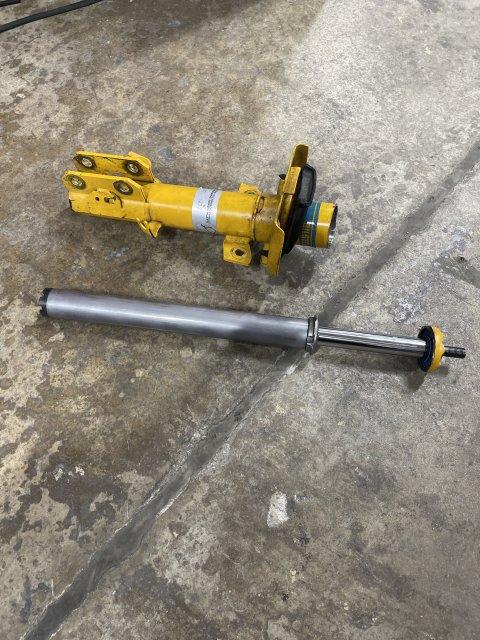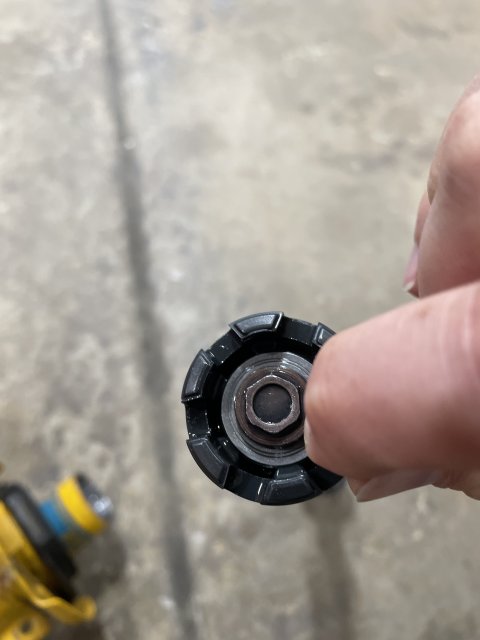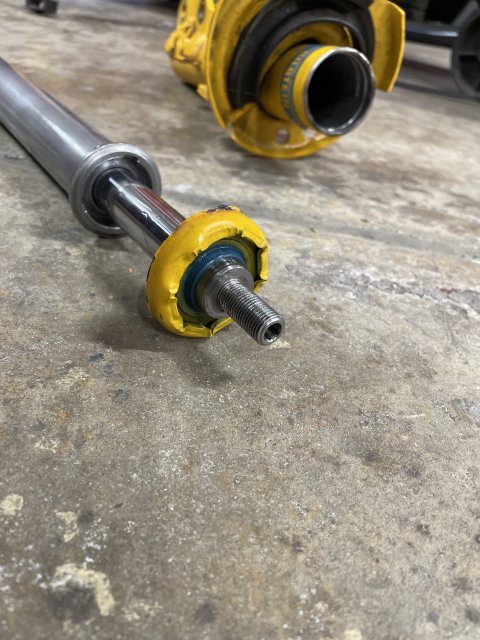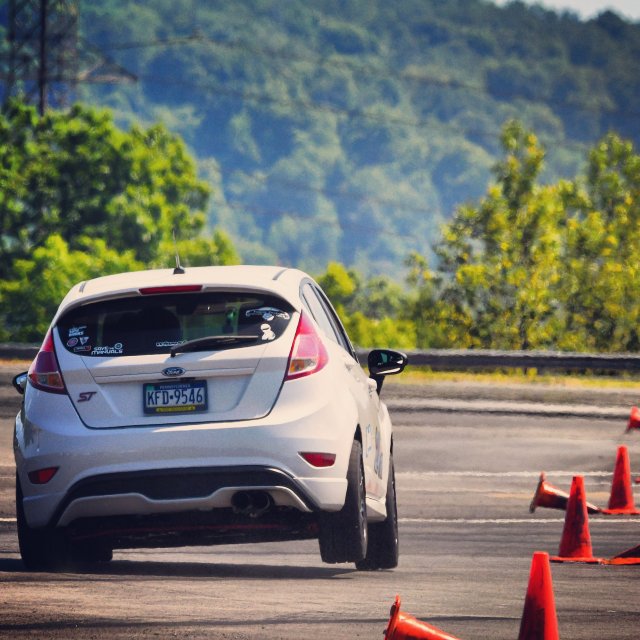-
Sign Up! To view all forums and unlock additional cool features
Welcome to the #1 Fiesta ST Forum and Fiesta ST community dedicated to Fiesta ST owners and enthusiasts. Register for an account, it's free and it's easy, so don't hesitate to join the Fiesta ST Forum today!
Bilstein Science Experiment
- Thread starter Fusion Works
- Start date
So, I'm gonna revive an older thread here. What is the consensus on upgraded dampers for the FiST with all that was just said? I'm currently at a roadblock where to take my car next, whether I go to a Koni, Bilstein, etc. damper and a lowering spring or bite the bullet and go full coilovers. I'm cautious going to coilovers because cost for good units aren't cheap, and I don't want them to get destroyed in the northeast winters. I do love the stock 16+ FiST suspension from the factory once a front strut bar was added. I've since put a Swift lowering spring on it and the stance is great and it feels pretty good under load but the turn in is not nearly as sharp as it used to be. I'll also add I've added poly bushings in the LCAs and installed poly rear spring perches.
All the testing done in this thread is fantastic. I'm not a suspension guru by any means, so this is quite helpful data being presented.
All the testing done in this thread is fantastic. I'm not a suspension guru by any means, so this is quite helpful data being presented.
Last edited:
I've since put a Swift lowering spring on it and the stance is great and it feels pretty good under load but the turn in is not nearly as sharp as it used to be.
Having gone from OEM to MeisterRs to B14, I would say one thing to get to sharpen up the turn in are the solid top hats, but that comes with sharper road bumps and the increased road noise (although as it turned out most of the increase I experienced were the RE71RS running low on thread). MeisterR and B14 don't seem to differ much in terms of front spring stiffness, but I could definitely feel the reduced brearing drag with pillow balls and the turn in was just delicious. In that respect, even with increased stiffness, B14 feels a lot more like OEM.
I had the B14 PSS kit, I didn't like it at all. Car felt super lazy comparatively and didn't think the ride quality was that much better IMO. I sold that kit. I want some more edge. I want the stock suspension but with lower ride height, better body control, and a hair more aggression. I think that's where I'm at. All the chassis bracing and bushings really brought the ride compliance up so now I want more performance. Fortune Auto coilovers aren't out of a possibility for me, I'm just worried about corrosion.
Thread Starter
#106
Thread Starter
#106
Try stock dampers with Swift Springs, then add a rear bar. That will fix your turn in issues. The stock dampers have stronger valving than all of the off the shelf replacement dampers. I have shown that in my dyno testing. I am not surprised you didn't like the B14 kit. The valving is really soft, where is should be much stiffer.
Try stock dampers with Swift Springs, then add a rear bar. That will fix your turn in issues. The stock dampers have stronger valving than all of the off the shelf replacement dampers. I have shown that in my dyno testing. I am not surprised you didn't like the B14 kit. The valving is really soft, where is should be much stiffer.
My goal for my car is to maintain the best characteristics of the factory car while making it better with minimal compromises, essentially "OEM plus" in the handling department with maybe even slightly more of an edge. I love this car, and I'll tweak it until the chassis rots away from me
Attachments
-
1.9 MB Views: 7
Fortune Auto coilovers aren't out of a possibility for me, I'm just worried about corrosion.
Spend $5K+ used and rebuilt, to $9K new on Rieger coil overs just to have the effing salt soup eat them alive?? Yeah, NO THANKS!
I will end up with the B6es under Swift Spec Rs, and use whatever method I need to/can find in order to raise the static ride height if they sit way too low for my needs.
![Wink [wink] [wink]](/images/smilies/wink.gif)
THIS is what finally dissuaded me from getting any coil over setup, most especially the insanely priced ones I was looking at, which make even the upper model/custom valved and multi-adjustable FAs seem downright inexpensive.
Spend $5K+ used and rebuilt, to $9K new on Rieger coil overs just to have the effing salt soup eat them alive?? Yeah, NO THANKS!![No No [nono] [nono]](/images/smilies/icon_smile_nono.gif)
Spend $5K+ used and rebuilt, to $9K new on Rieger coil overs just to have the effing salt soup eat them alive?? Yeah, NO THANKS!
Interesting, I wonder why. Could it be lower-than-optimal suspension height?
Having gone from OEM to MeisterRs to B14, I would say one thing to get to sharpen up the turn in are the solid top hats, but that comes with sharper road bumps and the increased road noise (although as it turned out most of the increase I experienced were the RE71RS running low on thread). MeisterR and B14 don't seem to differ much in terms of front spring stiffness, but I could definitely feel the reduced brearing drag with pillow balls and the turn in was just delicious. In that respect, even with increased stiffness, B14 feels a lot more like OEM.
Having gone from OEM to MeisterRs to B14, I would say one thing to get to sharpen up the turn in are the solid top hats, but that comes with sharper road bumps and the increased road noise (although as it turned out most of the increase I experienced were the RE71RS running low on thread). MeisterR and B14 don't seem to differ much in terms of front spring stiffness, but I could definitely feel the reduced brearing drag with pillow balls and the turn in was just delicious. In that respect, even with increased stiffness, B14 feels a lot more like OEM.
You really have to spend a lot more money to find better setups than these two brands. Bilsteins and Koni’s are off the shelf setups. They look at stock and valve according to stock and do not go further with any kind of testing. Neither are terrible but it’s the actual testing the other two companies took to get a setup that works well for our cars. Other brands do but they will cost you upwards of $2500.
So ya I could have told you tire noise on RE71r’s migHt be the cause .Just like someone running 888r’s or Federals 😂
nice thread!
I wrote this:
https://www.fiestastforum.com/threads/you-want-great-handling-look-at-race-cars.32185/
maybe it helps some of you that want the car to handle
I wrote this:
https://www.fiestastforum.com/threads/you-want-great-handling-look-at-race-cars.32185/
maybe it helps some of you that want the car to handle
If I do the coilover route, I'll definitely get covers for the springs to block the junk from getting in, but I'm unsure how the rest of it would hold up
Has anyone dynoed the Koni Sports?
I would expect softer than stock.
The Bilsteins are an odd combination of high quality, durable components. Their main division that supplies for OEM knows its stuff, but their aftermarket division doesn’t have much clue about shock tuning and usually have some direct increase over the stock profile. I think in our case, they did the development for the base Fiesta and never bothered with new damping curves when the ST came out.
If you’re willing to do take-apart work yourself, or find someone that can do revalves, and you or the shock tuner have good knowledge of how to actually tune dampers based on your individual vehicle and suspension setup, that’s where Bilsteins really shine.
The trick is either getting it right the first time, as they will last much longer just like OEM shocks (50-100k miles) without any adjustment or servicing, unlike even high end coilovers like Ohlins/Penske/Reiger that need frequent readjustment and manufacturers recommend only 20k miles or 40 hours on track before they should be disassembled and rebuilt, which is one of the downsides of the unfortunately delicate adjustment mechanisms which there’s no way around. Less expensive coilovers usually have even shorter service life, and you’ll be lucky if they dyno even close to the same at identical settings after 5-10k miles, if they were even that well matched from the factory.
Unfortunately unlike a lot of other vehicles, Bilstein chose not to use the 46mm HD monotube shocks for the B6 and B8 sets, and it appears we got cheap twin tubes for the basically the same price.
The B14 fronts are Motorsport dampers which are serviceable (as Fusionworks has shown) but the rears are small diameter (and crimped?), so you have to get creative. Sadly it’s not a cheap or fast process like it is for something like a Miata/BMW/Subaru/Etc that had a factory Bilstein option or B6/B8 HD damper. I’m in the process of adapting a 5125 inverted truck shock in the rear, but the damping off the shelf is totally inappropriate (mediocre digressive compression, and ridiculously stiff linear rebound), but they can be rebuilt and revalved. Hope to have more to show soon (unfortunately my shock tuner of choice is working through quite long backlog right now)
Pull back on rebound as your instinct is telling you, and you’ll be able to increase the front spring rate back to 300-350 lb/in to get the front frequency back in the 1.8-2.0 Hz range to get the handling you want without so much of the bone crushing ride.
I thought about it some more and I think I finally squared it for myself why B14 dampers are "oddly soft"... Ignoring the progressive nature for a second, since B14 springs are distinctly stiffer and the car mass is the same, they have higher undampened oscillation frequency and thus higher maximum vertical linear velocity. This means we have to look further down the dyno chart along the velocity axis to find the oscillation point. So then, this is why they made it ramp up that much slower, to exert similar damping force at higher frequencies that result from stiffer springs.
But then this only means any damper which targets stiffer springs would need to have softer (at any given frequency) damping that the one targeting softer springs? (again, for the same vehicle mass). Would be very curious to see a comparative dyno chart for a FiST coilover with say a 7kg spring.
Fully expecting the following to be entirely wrong but here it goes.
I thought about it some more and I think I finally squared it for myself why B14 dampers are "oddly soft"... Ignoring the progressive nature for a second, since B14 springs are distinctly stiffer and the car mass is the same, they have higher undampened oscillation frequency and thus higher maximum vertical linear velocity. This means we have to look further down the dyno chart along the velocity axis to find the oscillation point. So then, this is why they made it ramp up that much slower, to exert similar damping force at higher frequencies that result from stiffer springs.
But then this only means any damper which targets stiffer springs would need to have softer (at any given frequency) damping that the one targeting softer springs? (again, for the same vehicle mass). Would be very curious to see a comparative dyno chart for a FiST coilover with say a 7kg spring.
I thought about it some more and I think I finally squared it for myself why B14 dampers are "oddly soft"... Ignoring the progressive nature for a second, since B14 springs are distinctly stiffer and the car mass is the same, they have higher undampened oscillation frequency and thus higher maximum vertical linear velocity. This means we have to look further down the dyno chart along the velocity axis to find the oscillation point. So then, this is why they made it ramp up that much slower, to exert similar damping force at higher frequencies that result from stiffer springs.
But then this only means any damper which targets stiffer springs would need to have softer (at any given frequency) damping that the one targeting softer springs? (again, for the same vehicle mass). Would be very curious to see a comparative dyno chart for a FiST coilover with say a 7kg spring.
Most of what you “feel” in the suspension is not actually the bump you went over because the suspension absorbs most of it, but rather you feel the oscillation that happens afterwards as the energy is released. I say “most”, and not “all” because you’ll still feel the initial jerk from a combination of the seal friction and gas force that has to be overcome.
In practice what actually happens is that while the stiffer spring oscillates and settles more quickly following a bump, the amplitude is lower, and so the shock velocities are in a largely similar range - that’s why almost universally, the “knee” of most digressive shocks are somewhere around the 1-5 in/s range. Speeds below that are typically body roll, speeds above that occur on encountering bumps, dips and whoops on the road.
Some applications fall outside that range and there are various philosophies on where exactly to put the knee, but outside of high end racing, it’s less related to the spring rate chosen than it is other factors.
What’s more related to spring rate is the amplitude of the damping force, as ideally its tuned to accomplish some fraction of either slightly underdamped (some overshoot and trailing oscillation allowed after the first bounce) or near critically damped (just enough to arrest the first bounce without any overshoot. You never want an over damped suspension, as that means the suspension will take a very long time to settle and recover from a bump, at which point you’ve encountered another.
Because of the higher frequency, critical damping must arrest motion much faster to avoid oscillating (aka “Honda Bounce”) which means stiffer low speed damping. Because of how damper valving works, a higher knee always means high speed damping is always stiffer as well. Too much high speed damping is one of the causes of a harsh riding suspension.
There are two “common” schools of thought on critical damping ratio. (and many more uncommon/motorsort specific ones)
The first, like our stock suspension, many Japanese and cars with stiff “sporty” suspension as well as many,many aftermarket shock use asymmetric damping biased heavily towards or slightly past critically damped rebound to control body roll. This causes the car to hunker down (aka jack down) in corners, controlling body roll.
This typically produces an extremely harsh ride, and so it’s typically coupled with soft compression damping and a softer spring to mitigate harsh ride quality, and a tall progressive bumpstop that engages early to create a progressive setup to boost spring rate when cornering. When used with a stiffer aftermarket shock and spring or a coilover that is stiffer so as have linear springing without the aid of the bumpstop, the result is the typical brutal “racecar” ride quality.
The other approach which some call “old school” is stereotypically the “European” approach used in many German cars and luxury sports/GT cars and supercars. Think AMG Mercedes (but not Black Series) and some Porsches. A stiffer spring is chosen, with less damping that’s more symmetrical - compression damping is used to support the inside corner in addition to the rebound pulling the outside down. Ride quality is better due to less high speed damping, but this setup is harder to tune just right and get just enough low speed damping, and done poorly can produce a bit more oscillation and result in “floaty” feeling. If you haven’t guessed, the B14 uses this approach and might not have gotten it quite right (although much improved over the base model Fiesta which was the benchmark)
Neither approach is “wrong”, but factory “sport tuned suspension” has gravitated towards the Japanese approach, partly because it’s easier to get “right” and produce good handling, but also because consumers want a car that “feels” sporty and stiff regardless of how fast it actually is. Bad ride quality is actually a feature that sells cars…
Contrary to what you might think, ride quality is primarily a result of stiff damping and not stiff springs. The issue with stiff springs is actually getting enough damping to prevent the bouncy/floaty sensation, and the ball and chain is always that high speed damping is always baselined off the knee of the low speed, and with consumer grade shocks, you can’t make high speed damping flat (slope always goes up)
You never want an over damped suspension, as that means the suspension will take a very long time to settle and recover from a bump.
To me overdamped sounds like higher damping force which means stronger spring counteraction and energy dissipation which means quicker settling time, but what you're saying is it's somehow the opposite?
I'd like to briefly revisit this as I feel I'm misunderstanding "overdampened".
To me overdamped sounds like higher damping force which means stronger spring counteraction and energy dissipation which means quicker settling time, but what you're saying is it's somehow the opposite?
To me overdamped sounds like higher damping force which means stronger spring counteraction and energy dissipation which means quicker settling time, but what you're saying is it's somehow the opposite?
I'd like to briefly revisit this as I feel I'm misunderstanding "overdampened".
To me overdamped sounds like higher damping force which means stronger spring counteraction and energy dissipation which means quicker settling time, but what you're saying is it's somehow the opposite?
To me overdamped sounds like higher damping force which means stronger spring counteraction and energy dissipation which means quicker settling time, but what you're saying is it's somehow the opposite?
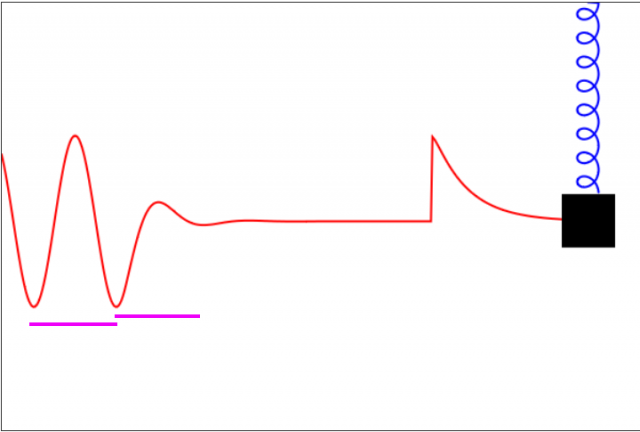
EDIT: I suppose what I had in my head if the shock is overdamped both ways then when a bump comes along, it wouldn't have had a chance to compress all the way either, so it would effectively not "unsettle" as much as in the above example, simply resulting in a stiff "bounce" over the bump.
Last edited:
Similar threads
-
Bilstein B8 and other hardware needed.
- Started by StevieST95
- Replies: 1
-
-
-
FS 2018 Fiesta w/recaros 59k miles, Bilstein B6s, TD 15x7 w/ Ecsta PS31 and S280 15.5k
- Started by Fimsaho
- Replies: 8
-
-
What boots and bumps fit your Bilstein B6's? Plus spring pointers needed....
- Started by Fish Freak
- Replies: 2
-
-
FS Bilstein B6's with springs, TB performance 2 point brace, Eibach rear sway bar
- Started by borg1087
- Replies: 13
-
-

